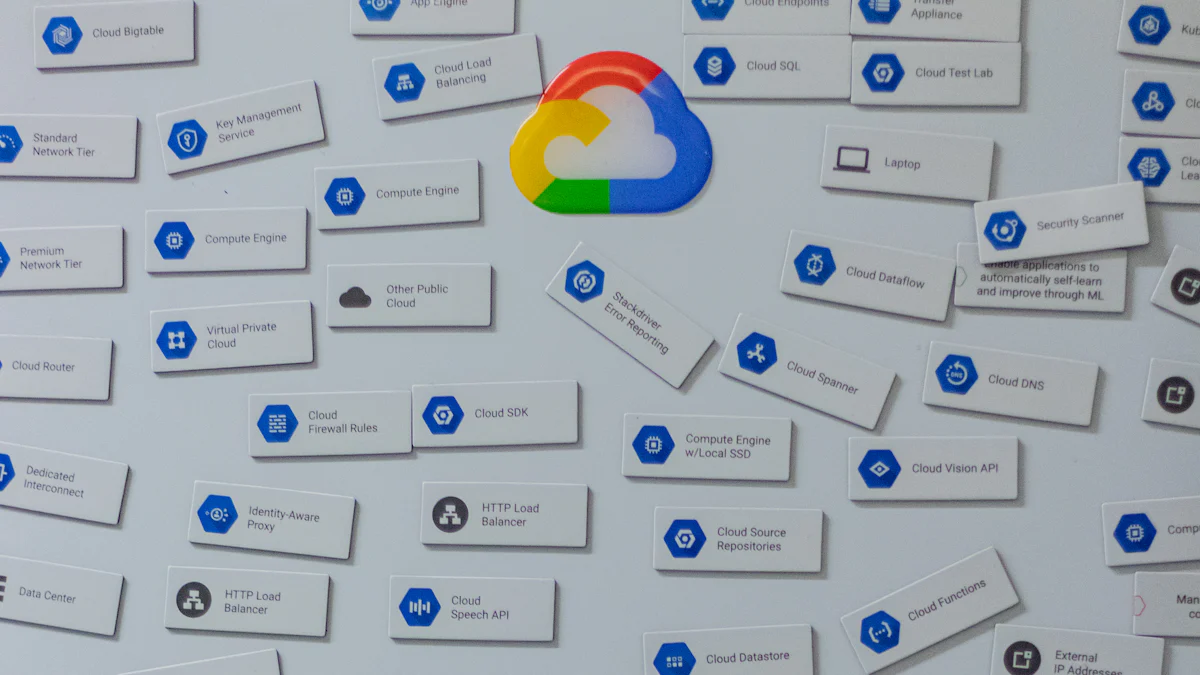Google Pub/Sub offers a fully-managed messaging service that enables real-time communication between applications. Integrating Google PubSub with Python provides developers with a powerful tool for building scalable and efficient systems. Python's simplicity and versatility make it an ideal choice for leveraging the capabilities of Google PubSub. This integration facilitates seamless data processing and event-driven architectures, enhancing the overall performance of applications.
Understanding Google Pub/Sub
What is Google Pub/Sub?
Google Pub/Sub serves as a fully managed messaging service that facilitates real-time communication between applications. This service allows different parts of an application to communicate independently, promoting scalability and reliability.
Key Features
- Scalability: Google Pub/Sub can handle large volumes of messages, making it suitable for applications with high throughput requirements.
- Reliability: The service ensures message delivery even in the face of network failures or other disruptions.
- Asynchronous Communication: Pub/Sub decouples message producers and consumers, allowing them to operate independently.
- Multiple Message Types: The service supports various message formats, enabling flexibility in data transmission.
- Integration with Other Google Cloud Services: Pub/Sub integrates seamlessly with services like Cloud Dataflow and BigQuery, enhancing data processing and analysis capabilities.
Use Cases
- Event-Driven Architectures: Pub/Sub enables applications to react to events in real-time, supporting use cases like monitoring, alerting, and automation.
- Real-Time Analytics: The service can ingest event streams and deliver them to analytics platforms for immediate processing and insights.
- Microservices Communication: Pub/Sub facilitates communication between microservices, ensuring that each component can operate independently while still interacting with others.
- IoT Data Ingestion: The service can handle data from numerous IoT devices, providing a scalable solution for collecting and processing sensor data.
How Google Pub/Sub Works
Google Pub/Sub operates on a publisher-subscriber model, where messages are sent to topics and received by subscribers.
Publisher-Subscriber Model
- Publisher: A publisher sends messages to a topic. Each message contains data that needs to be communicated to subscribers.
- Topic: A topic acts as a conduit for messages. Publishers send messages to topics, and subscribers receive messages from these topics.
- Subscriber: A subscriber receives messages from a topic. Subscribers can process these messages as needed.
Message Delivery and Acknowledgment
Message Delivery: Pub/Sub ensures that messages are delivered to all subscribers. The service supports both push and pull delivery methods.
- Push Delivery: Messages are sent directly to subscribers via HTTP endpoints.
- Pull Delivery: Subscribers pull messages from the topic at their convenience.
Acknowledgment: Subscribers must acknowledge receipt of messages. This acknowledgment ensures that the message has been processed and can be removed from the queue. If a message is not acknowledged, Pub/Sub will attempt to deliver it again.
Setting Up the Environment
Prerequisites
Google Cloud Account
A Google Cloud account is necessary to use Google Pub/Sub. Create an account on the Google Cloud Platform. The platform offers a free tier with limited usage, which is sufficient for initial testing and development.
Python Installed
Ensure that Python is installed on the system. Download and install Python from the official Python website. Verify the installation by running python --version in the command line.
Installing Required Libraries
Google Cloud Pub/Sub Client Library
Install the Google Cloud Pub/Sub client library to interact with the Pub/Sub service. Use the following command to install the library:
pip install google-cloud-pubsub
Other Dependencies
Additional dependencies may be required for specific use cases. Install these dependencies using pip. Commonly used libraries include google-auth for authentication and requests for making HTTP requests.
pip install google-auth requests
Configuring Google Cloud Project
Creating a Project
Create a new project on the Google Cloud Console. Navigate to the Google Cloud Console, click on the project dropdown, and select "New Project." Provide a name for the project and click "Create."
Enabling Pub/Sub API
Enable the Pub/Sub API for the project. In the Google Cloud Console, go to the "APIs & Services" section. Click on "Enable APIs and Services," search for "Pub/Sub API," and enable it.
Setting Up Authentication
Set up authentication using a service account. In the Google Cloud Console, navigate to "IAM & Admin" and select "Service Accounts." Create a new service account and download the JSON key file. Set the GOOGLE_APPLICATION_CREDENTIALS environment variable to the path of the JSON key file:
export GOOGLE_APPLICATION_CREDENTIALS="/path/to/your/service-account-file.json"
This setup ensures secure and authenticated access to Google Pub/Sub services.
Implementing Google Pub/Sub in Python
Creating a Publisher
Writing Publisher Code
To create a publisher in Google PubSub, start by importing the necessary libraries. Use the google-cloud-pubsub library to interact with the PubSub service.
from google.cloud import pubsub_v1
# Initialize a Publisher client
publisher = pubsub_v1.PublisherClient()
# Define the topic path
project_id = "your-project-id"
topic_id = "your-topic-id"
topic_path = publisher.topic_path(project_id, topic_id)
The PublisherClient class provides methods for creating and managing topics. The topic_path method constructs the full path of the topic.
Publishing Messages
Publish messages to the topic using the publish method. Each message must be encoded as bytes.
# Publish a message
message_data = "Hello, Google PubSub!"
future = publisher.publish(topic_path, message_data.encode("utf-8"))
# Confirm the message was published
print(f"Published message ID: {future.result()}")
The publish method returns a future object. Use the result method to confirm that the message was successfully published.
Creating a Subscriber
Writing Subscriber Code
To create a subscriber, import the necessary libraries and initialize a SubscriberClient.
from google.cloud import pubsub_v1
# Initialize a Subscriber client
subscriber = pubsub_v1.SubscriberClient()
# Define the subscription path
subscription_id = "your-subscription-id"
subscription_path = subscriber.subscription_path(project_id, subscription_id)
The SubscriberClient class provides methods for creating and managing subscriptions. The subscription_path method constructs the full path of the subscription.
Receiving Messages
Receive messages using the subscribe method. Define a callback function to process incoming messages.
def callback(message):
print(f"Received message: {message.data.decode('utf-8')}")
message.ack()
# Subscribe to the topic
streaming_pull_future = subscriber.subscribe(subscription_path, callback=callback)
# Keep the main thread alive to listen for messages
try:
streaming_pull_future.result()
except KeyboardInterrupt:
streaming_pull_future.cancel()
The callback function processes each message and acknowledges receipt using the ack method. The subscribe method listens for new messages and invokes the callback function.
Error Handling and Retries
Common Errors
Common errors in Google PubSub include network issues, authentication failures, and quota limits. Handle these errors to ensure reliable message delivery.
- Network Issues: Retry the operation if a network error occurs.
- Authentication Failures: Verify the service account credentials and permissions.
- Quota Limits: Monitor usage and request quota increases if necessary.
Implementing Retries
Implement retries using the retry module from the google.api_core library.
from google.api_core import retry
# Define a retry strategy
retry_strategy = retry.Retry(
initial=1.0, # Initial delay
maximum=10.0, # Maximum delay
multiplier=2.0, # Exponential backoff
deadline=60.0 # Total timeout
)
# Use the retry strategy when publishing messages
future = publisher.publish(topic_path, message_data.encode("utf-8"), retry=retry_strategy)
print(f"Published message ID: {future.result()}")
The Retry class provides a flexible way to handle transient errors. Customize the retry strategy based on the application's requirements.
Practical Use Cases
Real-Time Data Processing
Example Scenario
Real-time data processing plays a crucial role in modern applications. Consider an e-commerce platform that tracks user interactions. The platform needs to process events like page views, clicks, and purchases in real time. Google PubSub can handle this task efficiently.
Implementation Steps
Create a Topic: Set up a topic for user interaction events.
from google.cloud import pubsub_v1publisher = pubsub_v1.PublisherClient()topic_path = publisher.topic_path("your-project-id", "user-interactions")publisher.create_topic(name=topic_path)Publish Events: Send user interaction events to the topic.
event_data = "User clicked on product"future = publisher.publish(topic_path, event_data.encode("utf-8"))print(f"Published event ID: {future.result()}")Create a Subscription: Set up a subscription to receive events.
subscriber = pubsub_v1.SubscriberClient()subscription_path = subscriber.subscription_path("your-project-id", "user-interaction-subscription")subscriber.create_subscription(name=subscription_path, topic=topic_path)Process Events: Define a callback function to process received events.
def callback(message): print(f"Received event: {message.data.decode('utf-8')}") message.ack()streaming_pull_future = subscriber.subscribe(subscription_path, callback=callback)try: streaming_pull_future.result()except KeyboardInterrupt: streaming_pull_future.cancel()
Event-Driven Architectures
Example Scenario
Event-driven architectures enhance system responsiveness and scalability. Imagine a logistics company that needs to update shipment statuses in real time. Google PubSub can facilitate this by enabling asynchronous communication between services.
Implementation Steps
Create a Topic: Set up a topic for shipment status updates.
topic_path = publisher.topic_path("your-project-id", "shipment-status")publisher.create_topic(name=topic_path)Publish Status Updates: Send shipment status updates to the topic.
status_update = "Shipment delivered"future = publisher.publish(topic_path, status_update.encode("utf-8"))print(f"Published status update ID: {future.result()}")Create a Subscription: Set up a subscription to receive status updates.
subscription_path = subscriber.subscription_path("your-project-id", "shipment-status-subscription")subscriber.create_subscription(name=subscription_path, topic=topic_path)Process Status Updates: Define a callback function to process received updates.
def callback(message): print(f"Received status update: {message.data.decode('utf-8')}") message.ack()streaming_pull_future = subscriber.subscribe(subscription_path, callback=callback)try: streaming_pull_future.result()except KeyboardInterrupt: streaming_pull_future.cancel()
Google PubSub offers a robust solution for building real-time data processing systems and event-driven architectures. The service ensures reliable message delivery and scalability. Developers can leverage Google PubSub to create efficient and responsive applications.
Best Practices and Tips
Security Considerations
Authentication and Authorization
Google PubSub requires robust authentication and authorization mechanisms to ensure secure communication. Use service accounts for authentication. Service accounts provide a secure way to access Google Cloud resources. Assign appropriate roles to these accounts. Roles should follow the principle of least privilege. This means granting only the necessary permissions for tasks.
To set up a service account, navigate to the "IAM & Admin" section in the Google Cloud Console. Create a new service account and download the JSON key file. Set the GOOGLE_APPLICATION_CREDENTIALS environment variable to the path of this JSON key file.
export GOOGLE_APPLICATION_CREDENTIALS="/path/to/your/service-account-file.json"
This setup ensures that only authorized entities can publish and subscribe to topics.
Data Encryption
Data encryption is crucial for protecting sensitive information. Google PubSub supports both in-transit and at-rest encryption. In-transit encryption protects data as it travels between publishers, subscribers, and Google servers. At-rest encryption safeguards data stored on Google servers.
Google PubSub uses Transport Layer Security (TLS) for in-transit encryption. This protocol ensures that data remains confidential and tamper-proof during transmission. For at-rest encryption, Google Cloud automatically encrypts data using AES-256 encryption.
To enhance security further, consider using customer-managed encryption keys (CMEK). CMEK allows you to control the encryption keys used by Google PubSub. Navigate to the "Cloud Key Management" section in the Google Cloud Console to create and manage your encryption keys.
Performance Optimization
Efficient Message Handling
Efficient message handling is essential for maximizing Google PubSub's performance. Batch message publishing reduces the number of API calls. This approach minimizes latency and improves throughput. Use the batch_settings parameter in the PublisherClient to configure batch settings.
from google.cloud import pubsub_v1
batch_settings = pubsub_v1.types.BatchSettings(
max_bytes=1024, # Maximum size of a batch in bytes
max_latency=0.01, # Maximum latency in seconds
)
publisher = pubsub_v1.PublisherClient(batch_settings=batch_settings)
In addition, optimize message processing on the subscriber side. Use multithreading or multiprocessing to handle multiple messages concurrently. This approach ensures that subscribers can process messages quickly and efficiently.
Scaling Subscribers
Scaling subscribers is vital for handling high message volumes. Google PubSub supports horizontal scaling, allowing you to add more subscribers to distribute the load. Use multiple instances of your subscriber application to achieve this.
Consider using Kubernetes to manage and scale your subscriber instances. Kubernetes automates the deployment, scaling, and management of containerized applications. Deploy your subscriber application as a Kubernetes deployment. Configure the deployment to scale based on CPU or memory usage.
apiVersion: apps/v1
kind: Deployment
metadata:
name: pubsub-subscriber
spec:
replicas: 3 # Number of subscriber instances
selector:
matchLabels:
app: pubsub-subscriber
template:
metadata:
labels:
app: pubsub-subscriber
spec:
containers:
- name: subscriber
image: gcr.io/your-project-id/subscriber:latest
resources:
requests:
memory: "64Mi"
cpu: "250m"
limits:
memory: "128Mi"
cpu: "500m"
This configuration ensures that your subscriber application can scale dynamically to handle varying workloads.
Google Pub/Sub integration with Python offers a robust solution for real-time messaging and event-driven architectures. The guide covered key concepts, setup procedures, and implementation steps. Developers should experiment with the provided examples to enhance their understanding. Practical application will solidify knowledge and reveal potential optimizations. For further learning, consult Google Cloud documentation and explore additional tutorials.






